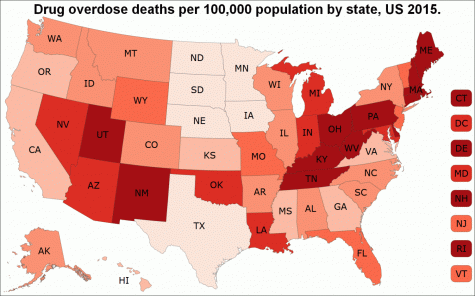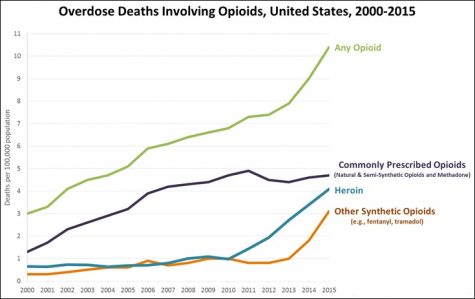Pennsylvania Fights Against the Opioid Epidemic
January 25, 2018
Governor Tom Wolf declared the heroin and opioid epidemic to be a statewide disaster emergency on January 10.
Wolf signed a statewide disaster declaration to enhance state response, improve access to treatment and save lives.
“While we have made progress in combating the heroin and opioid abuse crisis and drastically expanded Pennsylvania’s response, we are still losing far too many Pennsylvanians,” said Governor Wolf in the declaration.
Included in the declaration are the 13 Initial Initiatives, or new rules, that focus on enhancing data collection, improving tools for first responders, and expanding access to treatment.

In order to complete these tasks, the government plans to establish an Opioid Command Center which will expand access to prescription drug monitoring.
The declaration also allows for more access to treatment by waiving fees and licensing, so patients can receive it quicker and more efficiently.
However, Edward Bailey, an EMS chief at Glen Rock EMS Incorporated, believes that this declaration is only a temporary fix.
“As long as people are making that personal choice, you can’t legislate your way out of it,” said Bailey. “You can’t just give out the Narcan as everybody wants to do, and you know that sounds like an easy fix but it’s a band-aide. Did that solve the problem? No. It may save some lives but it may also be incentive for more people to give a look at it and give it a try.”
Narcan is a medication used to block the effects of opioids. In 2016, 13 people died every day due to drug-related overdose in Pennsylvania.
More than 95 percent of Pennsylvania’s counties reported fatal overdoses involving fentanyl, which is 30 to 50 percent more potent than heroin.

Bailey has been an EMT for 40 years and has first hand experience with how the epidemic has spread and impacted the state as a whole.
“I think it’s affected all areas and that’s why the governor recently put that down as a state of emergency,” said Bailey. “…its affecting areas in the middle of Cameron county as hard as its affecting downtown Philadelphia. It affects all demographics. We see as much use in the rich as the poor, there’s no ethnic background to it. It is an equal opportunity killer.”
As the country begins to transition from heroin to fentanyl, the death toll is expected to increase.
The Centers of Disease Control and Prevention estimates that Philadelphia suffered a higher rate of overdose deaths than any other major American city.
Philadelphia officials are taking action against the epidemic.
Mayor Jim Kenney is filing a lawsuit against Teva, Cephalon, Endo Pharmaceuticals, Allergan, Janssen Pharmaceutical, Johnson & Johnson and Purdue Pharma, who settled a lawsuit with the federal government for $634.5 million in 2007.
“The epidemic currently plaguing the city has exacted a grim toll on Philadelphia residents and their families,” said Kenney, according to Dan Stamm’s NBC article. “… the cause can be directly linked to methods used by manufacturers to market and sell their products to doctors and the public. Those tactics have to end.”
The suit plans to stop deceptive marketing practices and force the drug companies to pay for the treatment costs and the amount of money that the city has spent responding to the addiction epidemic.
So far, five of the seven companies being sued have released an official statement.
“Endo is dedicated to providing safe, quality products to patients in need, and we share the public concern regarding opioid abuse and misuse,” said Endo Pharmaceuticals, according to Dan Stamm’s NBC article. “We are committed to working collaboratively to develop and implement a comprehensive solution to the opioid crisis, which is a complex problem with several causes that are difficult to disentangle.”
Another idea Mayor Kenney wants to put into effect is placing an area in the neighborhood where those addicted to heroin could inject the drug under medical supervision.
Philadelphia officials like district attorney Larry Krasner agree with starting a safe injection site.
“The only way to get people to turn their lives around,” said Krasner, according to Bobby Allen’s NPR article, “is to keep them alive long enough so they can do that. And we’re going to do that.”
However, police officials, the federal government, and the community are not thrilled with the idea with supplying junkies a place to shoot up.
Drug Enforcement Administration agent Patrick Trainer believes that starting a safe injection site could lead to much worse.
“Is it going to stop with a safe injection site?” asks Trainer, according to Bobby Allen’s NPR article. “Are we going to do that and then, next year and the year following, are we then going to be talking about, OK, there are still overdose deaths, so maybe we need to look into government-supplied drugs?”
Residents of the neighborhood where the site would be placed feel uneasy as well.
The federal government does not approve of the establishment of a safe injection site either, not just people in Philadelphia.
When Vermont proposed a site in 2017, the U.S. attorney’s office released a official statement arguing against the proposition.
“As to policy, the proposed government-sanctioned sites would encourage and normalize heroin use,” stated the official statement, “thereby increasing demand for opiates and, by extension, risk of overdose and overdose deaths.”
However, safe injection sites show signs of doing the opposite.
In North America, there is only one location where addicts can shoot up under medical supervision.
Insite, located in Vancouver, opened in 2003.
Two years after its grand debut, overdose deaths in the surrounding areas dropped by 35 percent.
Decriminalizing drug addicts and providing them with safe places to inject shows evidence of actually decreasing the overall overdose death toll.
When Portugal removed criminal penalties for all drug use in 2001, the amount of addicts dropped to 30 a year and the number of deaths caused by overdose decreased to three for every 1,000,000 citizens.
Dr. Janice Pringle, director of the University of Pittsburgh School of Pharmacy evaluation and research unit at the University of Pittsburgh, has been studying the overdose crisis.
“We are not going to arrest our way out of this, and we are not going to treat our way out of this,” said Pringle, according to Alicia Victoria Lozano’s NBC article. “This has gone beyond our worst nightmares.”




